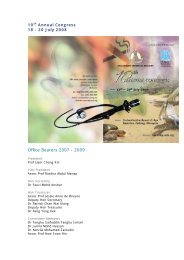download - Malaysian Thoracic Society
download - Malaysian Thoracic Society
download - Malaysian Thoracic Society
Create successful ePaper yourself
Turn your PDF publications into a flip-book with our unique Google optimized e-Paper software.
Annual Congress of <strong>Malaysian</strong> <strong>Thoracic</strong> <strong>Society</strong><br />
Symposium 4A<br />
Sleep Disorders<br />
Initiating continuous positive airway pressure (CPAP)<br />
in obstructive sleep apnea<br />
Amanda Piper<br />
Australia<br />
Continuous positive airway pressure is well established therapy for the management of obstructive sleep<br />
apnea (OSA), and is associated with substantial improvement in daytime functioning and quality of life.<br />
However, the effectiveness of CPAP is frequently hindered by poor or nonadherence to therapy. A multitude of<br />
factors can influence whether an individual accepts and then uses CPAP consistently. While previous studies<br />
have evaluated physiological and patient characteristics as predictors of adherence (1), more recent studies<br />
have focused on the role of psychological factors and cognitive perceptions in influencing the decision about<br />
CPAP use (2). Several studies have found early experiences with CPAP impact on the individual’s decision<br />
to use CPAP (2,3), and this early pattern of use predicts long term adherence (4). Consequently, promoting<br />
a positive initial experience with CPAP is seen as crucial in encouraging patients to continue therapy long<br />
term. Three key aspects of initiating CPAP therapy will be discussed: a) the impact on adherence of how an<br />
effective pressure level is titrated, b) improvements in device technology to lessen side-effects commonly<br />
associated with CPAP use and c) education and support of the individual commencing CPAP. Evidence to date<br />
suggests that simplified approaches to the determination of effective pressures have not impacted negatively<br />
on CPAP adherence, at least in appropriately selected individuals (5). Considerable effort has been put into<br />
modification of CPAP devices to lessen side effects, and while these have been effective in reducing symptoms<br />
associated with therapy use, there is currently little evidence that these have had a clinically significant impact<br />
on adherence, at least in CPAP naïve individuals (6). More recent work has shown that educational support<br />
combined with behavioural strategies employed early in the CPAP experience is most likely to influence CPAP<br />
use (7). In general, studies evaluating device modifications and educational strategies on CPAP adherence<br />
have assessed CPAP naïve patients with moderate to severe apnea. More work is needed to determine the<br />
impact of these interventions in subjects with much milder disease, and those who are likely to be, or are<br />
already established, as poorly adherent to therapy.<br />
References<br />
1. Weaver & Grunstein, Proc Am Thorac Soc 2008; 5:173-178<br />
2. Sawyer et al, Qual Health Res 2010;20:873-892<br />
3. Lewis et al, Sleep 2004;27:134-138<br />
4. Drake et al, Sleep 2003;26:308-311<br />
5. Collen et al, Sleep 2009;14:93-99<br />
6. Smith & Lasserson, Cochrane Database Syst Rev 2009<br />
7. Richards et al, Sleep 2007;30:635-40<br />
34








